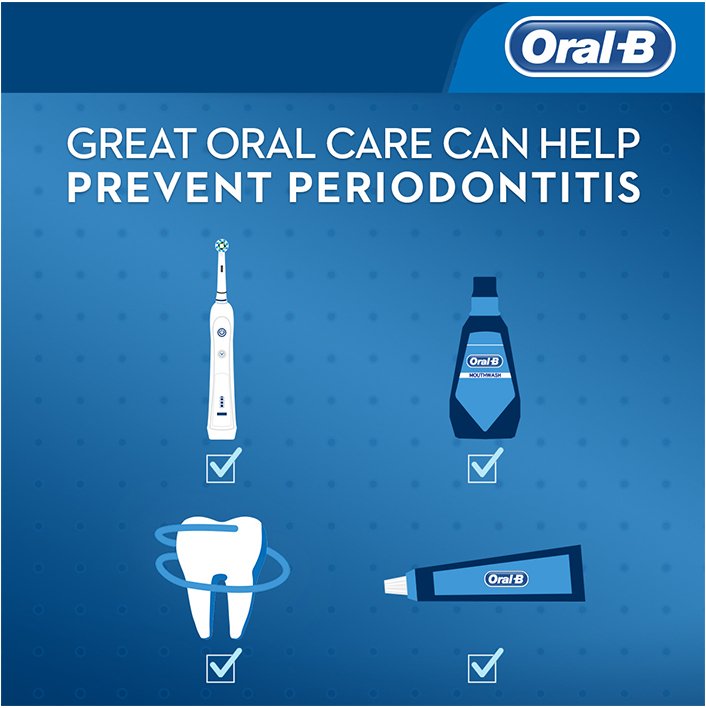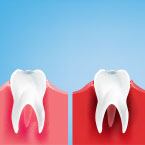WHAT IS PERIODONTITIS? TREATMENTS, SIGNS, AND SYMPTOMS

- Periodontitis: More Severe Form of Gum Disease
- Causes of Periodontitis
- Periodontitis Symptoms
- Periodontitis Treatment and Prevention
The mouth is the gateway to the body and can also show the early signs of serious health problems developing in other areas. This is why going to a dental professional for semi-annual checkups is important. One condition to stay on top of is periodontal disease. Often grouped together with gingivitis, it is a form of gum disease that can impact other areas of your mouth, including your teeth and tongue. For this reason, educating yourself on the subject, including how to prevent it and how to treat it, is important.
Periodontitis: More Severe Form of Gum Disease
While grouped with gum disease, periodontitis is essentially a more extreme case. Gingivitis begins as gum inflammation. If gingivitis goes without treatment, it develops into periodontitis, or gum disease. Eventually, the inner layers of the gum begin to pull away from the teeth. This forms pockets on either side of the teeth. The spaces collect debris brushing your teeth will not always remove, causing infection in the gums and the gum line to shrink. As the gum line shrinks, the pockets enlarge, and you run the risk of teeth falling out and suffering from other serious oral conditions.
Causes of Periodontitis
The major culprit of periodontitis is plaque. When plaque builds up around teeth, it begins to infect the gums, leading to gingivitis and eventually gum disease. However, there are secondary causes. For women, hormonal changes due to pregnancy, menopause or monthly menstruation can bring about the development of periodontal disease. Certain forms of illnesses, ranging from diabetes to HIV, can affect the immune system, resulting in a loss of elasticity in the gums.
Some oral forms of medication have a side effect resulting in the reduction of saliva. Saliva is used to protect the gums and teeth. Without adequate saliva, an abnormal growth of gum tissue may develop, or it may prevent food debris from washing down the throat, each of which has the potential of bringing on the disease. If you brush and floss every day yet you still are experiencing early signs of gum disease, you should see your primary healthcare physician as you may be experiencing other medical issues.
Most Advanced Electric Toothbrush for Periodontitis Treatment
662
Periodontitis Symptoms
Do your gums bleed after brushing your teeth? Chances are this is not because you are brushing too hard. It is due to early stages of gingivitis. Now, if you just started to floss again, you will likely see some blood due to the irritation it causes in the gums initially. However, this should only last a short amount of time and even so, your gums should not bleed just from brushing.
Other symptoms include swollen gums, the persistence of bad breath (or having a bad taste in your mouth), shifting teeth and the formation of pockets between your teeth and your gums. On top of this, it is possible you actually have gum disease but just can't see the conditions, depending on the area of the gums suffering from periodontitis. Seeing your dental professional every six months allows you to stay on top of this potential condition.

Periodontitis Treatment and Prevention
Preventing periodontal disease and the development of gingivitis is rather straight forward. Simply put, prevention is the best periodontal disease treatment. To catch dental problems before they become severe, it’s good to get into the habit of checking your mouth daily as part of your overall dental health care routine. Look for changes in the color or appearance of your teeth, gums, tongue, and gingival tissues. By following proper plaque control measures, periodontitis prevention should be easy. For starters, you must brush your teeth twice a day and floss at least once a day. Pair standard string floss with an irrigator like the Oral-B Water Flosser Advanced to help keep your gums healthy. Using an antibacterial rinse after you brush can clean out hard to reach plaque and, if you have developed pockets around the gums, it cleans out bacteria and debris stuck in the pockets, allowing your gums time to tighten back up. Additionally, going in to see your dental professional for semi-annual teeth cleanings is recommended.
So, what happens if you have developed the disease and need help with managing your periodontitis? Well, your dental professional will give you some toothpaste options, designed specifically for gum health. An Oral-B electric toothbrush helps with plaque control as well, the Oral-B iO Series 9, which removes 100% more plaque than a manual toothbrush. As long as the situation hasn't reached a critical level, this is really all you need to do (while following proper plaque control steps). However, if the pockets are large and will not return to normal on their own, oral surgery is needed to tighten the gum tissue back up. Severe periodontal disease treatment may also involve a deep cleaning procedure called scaling and root planing , in which the dental hygienist or dentist removes tartar from both above and below the gum line and smooths rough spots on tooth roots where plaque-causing bacteria tend to gather. By attending your regular dental appointments, you can avoid this kind of extreme treatment.

069055125946|069055125205|037000469568







